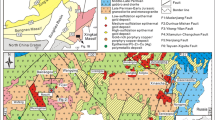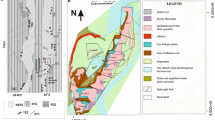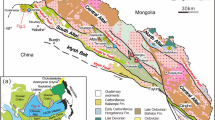Summary
The Kodaikanal massif is part of a Precambrian terrane characterized by granulite facies rocks. It is dominated by the widespread occurrence of charnockites. The observed textural relationships in these rocks are consistent with the following main reactions:
-
i.
Biotite + Quartz = Orthopyroxene + Alkali feldspar ± Garnet + Vapour
-
ii.
Garnet + Quartz = Orthopyroxene + Plagioclase
-
iii.
Pyrope = Mg Tschermaks + Enstatite (in Opx)
Garnet consuming reactions and the preservation of biotite-quartz-orthopyroxene-plagioclase symplectites are indicative of a decompression event. Progress of such reactions with decreasing pressure together with fluid inclusion data has implications for the construction of P-T vectors. Quartz from the charnockites contains the following fluid inclusions: (1) monophase high density CO2-rich (0.968/−1.014g/cm3) as the dominant fluid phase; (2) aqueous biphase CO2-H2O (0.888–0.915 g/cm3) and (3) late minor aqueous H2O inclusions with no visible CO2. CO2-isochores for the high density fluid inclusions yield a pressure limit of ca. 6.5 kbars, at granulite facies temperatures of ca. 800°C, which is in accordance with the estimation from mineralogical thermobarometry. The P-T path delineated from combined mineralogical and density data on carbonic inclusions is characteristically T-convex suggesting an isothermal decompression path and rapid uplift followed by cooling of a tectonically thickened crust.
Zusammenfassung
Das Kodaikanal Massiv ist ein Teil eines präkambrischen Granulitareals, das hauptsächlich aus Charnockiten aufgebaut wird. Die beobachteten, texturellen Beziehungen in diesen Gesteinen lassen sich mit den folgenden Mineralreaktionen in Übereinstimmung bringen:
-
i.
Biotit + Quarz = Orthopyroxen + Alkalifeldspat ± Granat + Vapour
-
ii.
Granat + Quarz = Orthopyroxen + Plagioklas
-
iii.
Pyrop = Mg Tschermak Komponente in OPX + Enstatit
Granatabbaureaktionen und das Auftreten von Symplektiten mit Biofit, Quarz, Orthopyroxen und Plagioklas, belegen ein Dekompressionsereignis. Das Ablaufen dieser Reaktionen mit fallendem Druck und die Daten der Untersuchungen an Flüssigkeitseinschlüssen sind für die Konstruktion des P-T Pfades bedeutsam. Quarz in Charnockiten führt folgende Flüssigkeitseinschlüsse: (1) Einphasige, sehr dichte, CO2-reiche Fluide (0.968–1.014g/cm3) dominieren. (2) Zweiphasige, wässrige, CO2-H2O (0.888–0.915 g/cm3) und (3) späte, CO2-freie, H2O-Einschlüsse treten untergeordnet auf. Aus den lsochoren der Einschlüsse hoher Dichte läßt sich ein Druck von 6.5 kbar bei granulitfaziellen Temperaturen von ca. 800 °C ableiten, was mit den geothermobarometrischen Ergebnissen übereinstimmt. Der aus den mineralogischen und Fl-Daten abzuleitendene P-T Pfad ist charakteristischerweise T-konvex ausgebildet und ist mit isothermischer Dekompression und rascher Hebung einer tektonisch vedickten Kruste erklärbar.
Similar content being viewed by others
References
Berman RG (1988) Internally consistent thermodynamic data for minerals in the system Na2O-K2O-CaO-MgO-FeO-Fe2O3-Al2O3-SiO2-TiO2-H2O-CO2. J Petrol 29: 445–522
Berman RG (1991) Thermobarometry using multi-equilibrium calculations: a new technique with petrological applications. Can Mineral 29: 833–855
Bhattacharya A, Krishna Kumar KR, Raith M, Sen SK (1991) An improved set of a-x parameters for Fe-Mg-Ca pyroxene garnet thermometer and orthopyroxene — garnet — plagioclase — quartz barometer. J Petrol 32: 629–656
Bohlen SR, Mezger K (1989) Origin of granulite terranes and the formation of the lowermost continental crust. Science 224: 326–329
Brown PE (1989) FLINCOR: a microcomputer program for the reduction and investigation of fluid inclusions data. Am Mineral 74: 1390–1393
Brown PE, Lamb WM (1986) Mixing of H2O-CO2 in fluid inclusions: geobarometry and Archean gold deposits. Geochim Cosmochim Acta 50: 847–852
Brown PE, Lamb WM (1989) P-V-T properties of fluids in the system H2O ± CO2 ± NaCl: new graphical presentations and implications for fluid inclusion studies. Geochim Cosmochim Acta 53: 1209–1221
Chacko T, Ravindra Kumar GR, Newton RC (1987) Metamorphic P-T conditions of the Kerala (South India) Khondalite belt: a granulite facies supracrustal terrain. J Geol 95: 343–350
Choudhary AK, Harris NBW, Calsteren PV, Hawkesworth CJ (1992) Pan-African charnockite formation in Kerala, South India. Geol Mag 129: 257–264
Collins PLF (1979) Gas hydrates in CO2 bearing fluid inclusion and use of freezing data for estimation of salinities. Econ Geol 74: 1435–1444
Coolen JJMMM (1982) Carbonic fluid inclusions in granulites from Tanzania. A comparison of geobarometric methods based on fluid density and mineral chemistry. Chem Geol 37: 59–77
Dasgupta S, Sanyal S, Sengupta P, Fukuoka M (1994) Petrology of granulites from Anakapalle-evidence for proterozoic decompression in the eastern gbats, India. J Petrol 35: 433–459
Drury SA, Harris NBW, Holt RW, Reeves-Smith GJ, Wightman RT (1984) Precambrian tectonics and crustal evolution in South India. J Geol 92: 3–20
Eckert JO Jr, Newton RC, Kleppa OJ (1991) ▴H of reaction and recalibration of garnet — pyroxene — plagioclase — quartz geobarometers in CMAS system by solution calorimetry of stoichiometric mineral mixes. Am Mineral 76: 148–160
Griffiths JB, Jahn BM, Sen SK (1987) Sm-Nd isotopes and REE geochemistry of Madras granulites, India: an introductory statement. Precamb Res 37: 343–355
Hansen EC, Newton RC, Janardhan AS (1984) Fluid inclusion in rocks from the amphibolitefacies gneiss to charnockite progression in Southern Karnataka India: direct evidence of the fluids of granulite facies metamorphism. J Metamorph Geol 2: 249–264
Hansen EC, Hickman MH, Grant NK, Newton RC (1985) Pan-African age of ‘Peninsular Gneiss’ near Madurai, South India. EOS 66: 419–420
Hansen EC, Janardhan AS, Newton RC, Prame WKBN, Ravindra Kumar GR (1987) Arrested charnockite formation in southern India and Sri Lanka. Contrib Mineral Petrol 96: 225–244
Harley SL (1984) An experimental study of the partitioning of Fe and Mg between garnet and orthopyroxene. Contrib Mineral Petrol 86: 359–373
Harley SL (1989) The origins of granulites: a metamorphic perspective. Geol Mag 126: 215–331
Harris NBW (1981) The application of spinel-bearing metapelites to P-T determinations: an example from South India. Contrib Mineral Petrol 76: 229–233
Harris NBW, Holt RW, Drury SA (1982) Geobarometry, geothermometry and late Archean geotherms from the granulite facies terrain of South India. J Geol 10: 509–527
Hollister LS, Burruss RL (1976) Phase equilibria in fluid inclusions from the Khtada Lake metamorphic complex. Geochim Cosmochim Acta 40: 163–175
Hollister LS, Burruss RL, Henry DL, Hendal EM (1979) Physical conditions during uplift of metamorphic terranes, as recorded by fluid inclusions. Bull Mineral 102: 555–561
Janardhan AS, Newton RC, Hansen EC (1982) The transformation of amphibolite facies gneiss to charnockite in southern Karnataka and northern Tamil Nadu, India. Contrib Mineral Petrol 79: 130–149
Lal RK (1993) New internally consistent calibrations of the mineral equilibria involving garnet-orthopyroxene-plagioclase- quartz for the geothermobarometry and their application to the Southern Indian granulites. J Metamorph Geol 11: 855–866
Lamb WM, Valley JW, Brown PE (1987) Post metamorphic CO2-rich fluid inclusions in granulites. Contrib Mineral Petrol 96: 485–495
Lamb WM, Brown PE, Valley JW (1991) Fluid inclusions in Adirondack granulites: implications for the retrograde P-T path. Contrib Mineral Petrol 107: 472–483
Mohan A, Windley BF (1993) Crustal trajectory of sapphirme-bearing granulites from Ganguvarpatti, South India: evidence for an isothermal decompression path. J Metamorph Geol 11: 867–878
Motoyosh Y (1990) A review of P-T evolution of high-grade metamorphic terrances in East Antarctica. In:Hiroi Y, Motoyoshi Y (eds) Study of geologic correlation between Srilanka and Antarctica. Interim Report of Japan-Sri Lanka joint research, pp 132–139
Nanda Kumar V, Santosh M, Yoshida M (1991) Decompression Granulites of Southern Kerala, South India: microstructure mineral chemistry. J Geosci Osaka City Univ 34: 119–145
Naqvi SM, Rogers JJW (1987) Precambrian geology of India. Oxford University Press, Oxford New York 223pp
Newton RC (1990) The late Archean high-grade terrain of South India and the deep structure of the Dharwar craton. In:Salisbury MH, Fountain DM (eds) Exposed cross-sections of the continental crust. Kluwar Academic Publishers, Dordrecht Boston London, pp 305–326
Newton RC (1992) Charnockite alteration: evidence for CO2 infiltration in granulite facies metamorphism. J Metamorph Geol 10: 383–400
Newton RC, Perkins D III (1982) Thermodynamic calibration of geobarometers based on the assemblages garnet-plagioclase- orthopyroxene (clinopyroxene)-quartz. Am Mineral 67: 203–222
Newton RC, Smith JV, Windley BF (1980) Carbonic metamorphism, granulites and crustal growth. Nature 288: 45–50
Ramakrishnan M (1991) Evolution of the high grade terrain of Southern India and Sri Lanka. Abstracts, International field workshop and seminar on composition and evolution of high- grade gneiss Terrains, Kandy, Sept 1991, pp 57–59
Ramchandran C (1992) P-wave velocity in granulites from South India: implications for the continental crust. Tectonophysics 201: 187–198
Ravindra Kumar GR, Chacko T (1994) Geothermobarometry of mafic granulites and metapelite from the Palghat gap region, South India: petrological evidence for isothermal uplift and rapid cooling. J Metamorph Geol 12: 479–492
Ravindra Kumar GR, Srikantappa C (1995) Arrested charnockite formation in the Palghat region, South India. J Geol Soc India 45: 145–162
Roedder E (1984) Fluid inclusions. Mineral Soc Am, Rev Mineral 12: 644pp
Santosh M (1987) Cordierite gneisses of Southern Kerala, India: petrology, fluid inclusions and implications for crustal uplift history. Contrib Mineral Petrol 96: 343–356
Santosh M (1992) Carbonic fluids in granulites: cause or consequence. J Geol Soc India 39: 375–399
Santosh M, Yoshida M, Nanda Kumar V (1991) Fluid characteristics across a gneisscharnockite reaction front in Sri Lanka: implications for granulite formation in the Gandwanian deep crust. J Min Pet Econ Geol 86: 27–44
Sen SK, Bhattacharya A (1984) An orthopyroxene-garnet thermometer and its application to the Madras Charnockites. Contrib Mineral Petrol 88: 64–71
Sivasubramanian P, Natarajan R, Janardhan AS (1991) Sapphirine-bearing assemblages from Perumalmalai, Palni Hills, Tamil Nadu. J Geol Soc India 38: 532–537
Srikantappa C, Raith M, Touret JLR (1992) Synmetamorphic high-density carbonic fluids in the lower crust: evidence from the Nilgiri granulites, southern India. J Petrol 4: 733–760
Srikantappa C, Venugopal L, Devaraju J, Basavalingu B (1994) P-T conditions of metamorphism and fluid inclusion characteristics of the Coorg granulites, Karnataka. J Geol Soc India 44: 495–504
Thompson AB, England PC (1984) Pressure-temperature-time paths of regional metamorphism. II. Their inference and interpretation using mineral assemblages in metamorphic rocks. J Petrol 25: 929–954
Touret JLR (1971) Le facies granulite en Norvege meridionale. II. Les inclusions fluids. Lithos 4: 423–436
Touret JLR (1987) Fluid inclusions and pressure-temperature estimates in deep-seated rocks. In:Helgeson HC (ed) Chemical transport in metasomatic processes. NATO ASI Series (C): Math Phys Sci 218: 91–121
Touret JLR, Dietvorst P (1983) Fluid inclusions in high-grade anatectic metamorphites. J Geol Soc Lond: 635–649
Touret JLR, Hansteen TH (1988) Geothermobarometry and fluid inclusions in a rock from Doddabetta charnockite complex, Southern India. Rendiconti Soc Ital Mineral Petrol 43: 65–82
Vry JK, Brown PE (1986) Fluid inclusions in archean granulites-Pikwitonei domain, Monitoba. Geol Soc Canada Abst Prog 11: 140
Wihnart E, Clocchiatti R, Duchesene JC, Touret JLR (1991) Fluid inclusions in charnockites from the Bjerkreim-Sokndal massif (Rogaland, southwestern Norway): fluid origin and in situ evolution. Contrib Mineral Petrol 108: 453–462
Winslow DM, Bondar RJ, Tracy RJ (1994) Fluid inclusion evidence for an anticlockwise metamorphic P-T path in central Massachusetts. J Met Geol 12: 361–371
Author information
Authors and Affiliations
Additional information
With 6 Figures
Rights and permissions
About this article
Cite this article
Mohan, A., Prakash, D. & Sachan, H.K. Fluid inclusions in charnockites from Kodaikanal massif (South India): P-T record and implications for crustal uplift history. Mineralogy and Petrology 57, 167–184 (1996). https://doi.org/10.1007/BF01162357
Received:
Accepted:
Issue Date:
DOI: https://doi.org/10.1007/BF01162357




